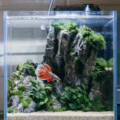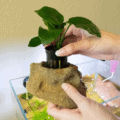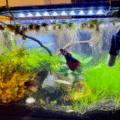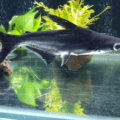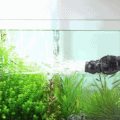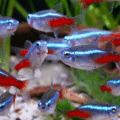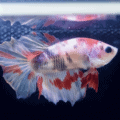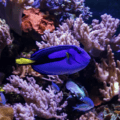Red Root Floaters stand out as one of the most captivating aquatic plants in the realm of aquascaping. With their vivid red roots and lush green foliage, these floating plants add a touch of natural beauty to any aquarium setup. In this comprehensive guide, we will delve into every aspect of caring for, planting, and propagating Red Root Floaters.

Introduction:
In the world of aqua scaping, Root Floaters (Phyllanthus fluitans) are among the few aquatic plants that have mesmerized the hobbyist. With its vibrant red roots and lush green foliage, this floating plant imparts a touch of natural beauty and grace to any aquarium setup.
In this thorough guide, we will study every aspect of caring for, planting, and propagating Red Root Floater, along with its numerous benefits in the aquatic ecosystem.
| Scientific Name | Phyllanthus fluitans |
| Common Name | Red Root Floater |
| Origin | South America |
| Light Requirements | Moderate to High light |
| Size | 05 to 1 inch |
| PH | 6.5 to 7.5 |
| Growth Rate | Fast |
| Planting Method | Floating; does not require planting in substrate |
Origin:
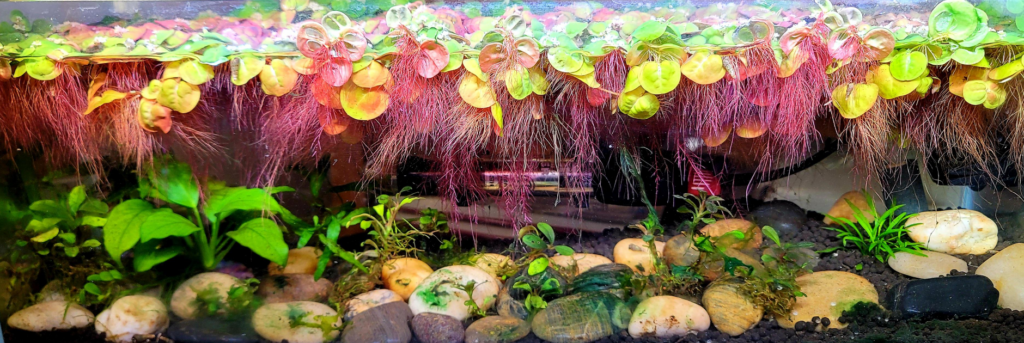
Red Root Floater or Floating spurge originates from the Amazon River basin in South America, where it flourishes in warm, nutrient-rich waters. It is present on the surface of slow-moving streams, rivers, and flooded areas, absorbing nutrients directly from the water column.
Size:
Red Root Floaters usually exhibit small, round leaves that range in size from 0.5 to 1 inch (1.27 to 2.54 cm) in diameter. The most notable characteristic of this plant is its vivid red roots, which can extend several inches below the water’s surface, enhancing the aquarium with bursts of color.
Right Aquarium Size:
When thinking about adding a Red Root Floater plant into an aquarium, it’s necessary to provide sufficient space for its growth and expansion. Due to its floating nature, this plant does not require planting in the substrate and can grow well in tanks of different sizes.
However, for the best results in growth and appearance, it is advisable to use larger aquariums with stable water parameters. A tank size of at least 10 gallons or more provides sufficient surface area for Red Root Floater to flourish without overcrowding.
Caring for Red Root Floater:

Red Root Floater care is relatively straightforward, making it an ideal choice for both novice and experienced aquarists.
Lighting:
Red Floaters care requires moderate to high lighting conditions for optimal growth. It should receive 8 to 10 hours of light per day but be cautious not to subject it to direct sunlight, as this can trigger excessive algae growth. Modify the intensity and duration of lighting according to the requirements of other plants and inhabitants in your aquarium.
Maintain Stable Temperature:
Red Root Floater) likes the water temperature that is between 72°F to 82°F (22°C to 28°C). Use a reliable aquarium heater to sustain water temperature within this range, as variations can stress the plant and hinder its growth.
Monitor pH and Water Hardness:
Red Root Floater tolerates a wide range of pH levels, ideally between 6.5 to 7.5. Similarly, it can adapt to varying water hardness levels, but slightly soft to moderately hard water is preferred.
Provide Nutrient Supplementation:
Floating spurges obtain most of their nutrients from the water column, and supplemental fertilization to improve growth and coloration. Liquid fertilizers or root tabs containing essential nutrients such as nitrogen, phosphorus, and potassium can be added to the aquarium according to manufacturer guidelines. These nutrients are mainly beneficial for plants with red roots like Red Root Floater.
Ensure Adequate Water Circulation:
Gentle water movement is beneficial for the Red Root Floater, helping to distribute nutrients and prevent stagnation.
Prune as Needed:
Consistent trimming is necessary to avoid overcrowding and preserve the floater leaves visual attractiveness. Use clean aquatic scissors or trimming tools to prune any excess growth, aiming to remove dead or deteriorating leaves and roots.
How to Plant Red Root Floater:

Unlike traditional aquatic plants that are rooted in the substrate, the Red Root Floater is a floating plant that requires a different planting approach. Here’s a step-by-step guide for setting floater plants for aquarium:
Prepare the Plant:
Begin by thoroughly examining the Red Root Floater for any signs of damage or decay. Gently remove any dead or discolored leaves, and make sure that only healthy specimens are planted.
Introduce to the Aquarium:
With clean hands or using aqua-scaping tweezers, gently place the Red Root Floater clusters onto the surface of the aquarium water. Allow them to float freely, dispersing the floater aquarium plants equally to cover the water’s surface.
Provide Adequate Space:
Ensure that there is enough distance between each floater aquarium plant’s cluster to prevent overcrowding and shading. Do not position them near filter outlets or areas with strong water flow, as this can cause the plants to clump together or flow away
Monitor and Adjust:
After planting the Red Root Floater, monitor its growth and distribution regularly. Adjust the location of clusters as needed to maintain an even division across the water’s surface and prevent too much shading of lower-lying plants with red root.
Propagating Red Root Floater:

Propagating Red Root Floating plant is a simple process that allows aquarists to expand their plant collection and fill out their aquarium with lush floating foliage. Here’s how to propagate Red Root Floater:
Identify Healthy Specimens:
Select mature and healthy Red Root Floating plant clusters with vibrant foliage and strong root systems for reproduction. Refrain from using specimens that show signs of disease, damage, or poor growth.
Separate Clusters:
Carefully detach the Red Roof Floaters cluster from the main group, ensuring that each cluster comprises a substantial number of healthy leaves and roots. Use clean hands or aqua-scaping tools to handle the plants, to prevent damaging delicate foliage.
Trim and Thin as Needed:
As propagated Red Root Floater clusters grow and multiply, trim back extra foliage and thin out overcrowded regions to maintain aesthetics.
Beyond its stunning visual appeal, floater aquarium plants offers several benefits to the aquatic ecosystem:
Water Filtration:
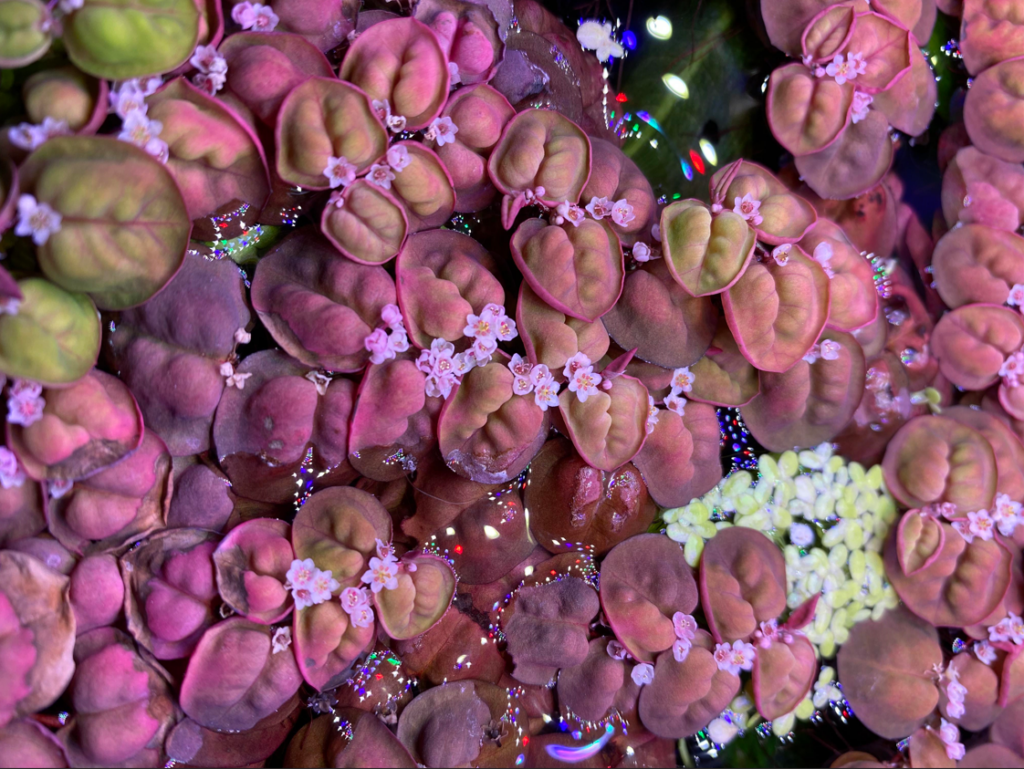
Floater aquarium plants help in water filtration by removing excess nutrients, impurities, and heavy metals from the water column, thereby decreasing the likelihood of algae overgrowth, and stimulating a more robust aquatic environment.
Oxygenation:
As a floating plant, this helps in keeping optimal oxygen levels for fish and other aquatic inhabitants, enhancing their health and well-being.
Natural Habitat:
Red Root Floater provides shelter, spawning sites, and foraging areas for small fish, shrimp, and other aquatic organisms. It mirrors the natural habitat.
Natural Behavior:
Red Root Floater encourages natural behaviors in fish and other aquatic inhabitants, such as exploration, grazing, and shelter-seeking.
Conclusion
Red Root Floater is more than just a beautiful aquatic plant – it’s a valuable addition to any aquarium, offering numerous benefits for both the aquatic ecosystem and its inhabitants. By providing optimal care, planting, and propagation, you can enjoy the vibrant beauty and ecological value of Red Root Floater in your aquatic paradise.

